Technique
If you can say it, you can do it...

If you're serious about learning classical ballet, you will learn the vocabulary. And if you're serious about learning the vocabulary, you will make a small investment in this very valuable book... Technical Manual and Dictionary of Classical Ballet by Gail Grant. It is tiny (fits conveniently in a dance bag) and remarkably inexpensive (under $5) but it is packed with useful information. It is considerably more detailed than any of the online ballet dictionaries. You can order it right now from many online vendors. Excerpts from this book are used throughout this technique page.
Positions of the Body
I teach Cecchetti (Italian) ballet technique and as such use the Cechetti body positions. I borrow one position (efface derriere) from the Vaganova (Russian) school since no comparable position exists in the Cechetti vocabulary.

Croise devant

Quatrieme devant

Efface (devant)

A la seconde

Croise derriere

Ecarte

Epaule

Quatrieme derriere
Although I do not teach from the Vaganova (Russian) school, the Vaganova positions here are given for completeness.

Efface derriere

Croise devant

Quatrieme devant

Efface devant

A la seconde

Croise derriere
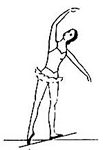
Ecarte devant

Epaule devant

Quatrieme derriere

Epaule derriere

Efface derriere
Vocabulary
ADAGIO - a series of exercises consisting of a succession of slow and graceful movements,. These exercises develop a sustaining power, sense of line, balance and poise which enables the dancer to perform with majesty and grace
ALLEGRO - a term applied to all bright and brisk movements. The most important qualities to aim at in allegro are lightness, smoothness, and ballon
ARABESQUE - One leg extended behind and the arms held in various harmonious positions creating the longest possible line from the fingertips to the toes.
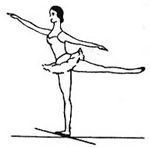
1st Arabesque
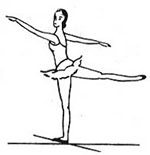
2nd Arabesque
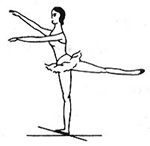
3rd Arabesque
ASSEMBLE: A step in which the working foot slides on the floor before being swept into the air. As the foot goes into the air the dancer pushes off the floor with the supporting leg, extending the toes. Both legs come to the ground simultaneously in the fifth position.
ATTITUDE - a particular pose in dancing derived by Carlo Blasis from the statue of Mercury by Giovanni da Bologna. It is a position on one leg with the other lifted in back, with the knee bent at an angle.
BALANCE - Rocking step
BALANCOIRE - like a seesaw
BALLON is the light, elastic quality in jumping in which the dancer bounds up from the floor, pauses a moment in the air and descends lightly and softly, only to rebound in the air like the smooth bouncing of a ball.
BALLONNE - bounced, ball-like
BALLOTTE - tossed
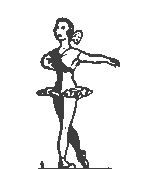
BARRE - side practice
BATTEMENT - beating. This is a demontration of GRAND BATTEMENT (Large battement) - An exercise in which the working leg is raised from the hip into the air and brought down again, the accent being on the downward movement, both knees stratight. This must be done with apparent ease, the rest of the body remaining quiet.
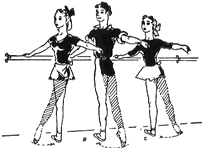
BATTEAU - Beat.
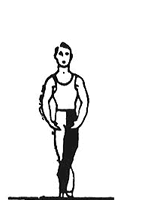
BRISE - broken
BRISE VOLE - flying brise.
CHANGEMENT - to change. . .
CHAINES or DEBOULES - progressive turn across the stage
CABRIOLE - from the Italian CAPRIOLA, a she-goat, a caper... All steps of elevation begin and end with a plie. CABRIOLE can also be done a la quatrieme derriere.

CAMBRE - arched
CHASSE - chased
EN CLOCHE. . . like a bell
COU-DE-PIED - neck of the foot. SUR LE COU-DE-PIED - on the neck of the foot. In the Cecchetti method, sur le cou-de-pied devant is the position of the working foot placed with the outside face of the heel in front of the supporting foot just above the ankle bone with all five toes resting on the floor sur la demi-point. Sur le cou-de-pied derriere is the same position with the inside face of the heel placed behind the supporting joot just above the ankle joing.
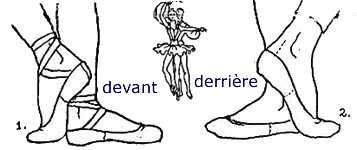
COUPE - cutting
COURU - running
EN CROIX - in the shape of a cross
PAS DE CHAT - cat step.
DEGAGE - disengaged
DETOURNE - backward turn on one foot
DEVELOPPE - developed

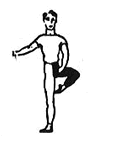


ECHAPPE - Escape - Saute' or sur les pointes, in each case echappes are done to the second or fourth position, both feet traveling an equal distance from the original center of gravity
ELAN - Attack
ELANCE - Darting
EMBOITE - fitted together, boxed
ENTRECHAT - Interweaving or braiding
EN DEDANS - inside, into your center
EN DEHORS - outside, away from your center
EPAULMENT - The placing of the shoulders
FONDU - Sinking down or melting
FOUETTE - Whipped...

FOUETTE ROND DE JAMBE EN TOURNANT. . . .
FRAPPE - to strike or hit.
GARGOUILLADE - Gurgling, to quote Kay Ambrose: "You do so much with your feet that you don't know what you've done."
GATEWAY - This position of the arms corresponds to the fifth position en avant
GLISSADE - to glide. A traveling step used to link other steps.
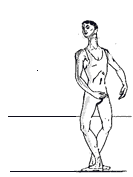
GLISSADE PRECIPITEE - Glissade hurried.
JETE - thrown. A jump from one foot to the other preceded by a brush with the working leg. There are 37 variations of jete. GRAND JETE EN TOURNANT - large jete turning.

PAS COURU - Running step
PAS DE BASQUE - step of the national dance of the Basques. This movement is found in some form in almost every folk dance the world over
PAS DE BOURREE - also from a folk dance from Auvergne, an old province of France
PAS DE CHAT - step of the cat

PAS DE CHEVAL - step of the horse
PAS MARCHE - a walking step.
PAS DE DEUX-TROIS-QUATRE - dance for two, three, four
PIED - foot. Dancers' feet are all important to them. They must take care that blisters and bunions do not interfere with their careers. DRU KRAFT was tired of me telling you about the 26 bones in the feet, so she gave me a pair of socks that shows them all.
PIQUE - stepping directly en pointe from a plie
PORT DE BRAS - Carriage of the arms. The term port de bras has two meanings: (1) A movement or series of movements made by passing the arm or arms through various positions. The passage of the arms from one position to another constitutes a port de bras. (2) A term for a group or exercises designed to make the arms move gracefully and harmoniously. In the Cecchetti method there are eight set exercises on port de bras.
In the execution of port de bras the arms should move from the shoulder and not from the elbow, and the movement should be smooth and flowing. In raising the arms from one position to another the arms must pass through a positions known in dancing as the "gateway". This position corresponds to the fifth position en avant.
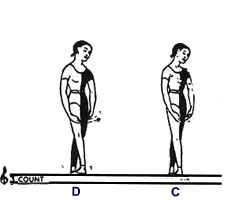
PROMENADE - turning on one foot in place
PIROUETTE - to whirl or spin. Pirouettes require perfect balance and every pirouette is entirely dependent on the preparation which precedes it. The dancer should make use of all the toes of the supporting foot, pressing them strongly against the ground to increase the area of support. The opening arm gives the lead and the incoming arm gives additional impetus. The head is the last to move as the body turns away from the spectator and the first to arrive as the body comes around toward the spectator.
RACCOURCI - Shortened. A term of the French School. (1) A position in which the thigh is raised ot the second position en l'air, with the knee bent so that the pointed toe rests against the knee of the supporting leg (retire). (2) A sharp bending movement of the knee, as in battement raccourci.
RELEVÉ - Raised.
RENVERSÉ - Upset, reversed.
RETIRÉ - Withdrawn. A position in which the thigh is raised to the second position en l'air with the knee bent so that the pointed toe rests in front of, behind or to the side of the supporting knee.
REVERENCE - Curtsey. The elaborate curtsey performed by the female dancer to acknowledge the applause of the audience. It is also done at the end of a ballet class to show the respectful admiration of the pupils for their teacher.
RIVOLTADE - A French term derived from the Italian "rivoltare" - to turn over.
ROND DE JAMBE - Round of the leg - that is, a circular movement of the leg.
ROYALE - Royal. A changement in which the calves are beaten together before the feet change position.
SOUBRESAUT - Sudden spring or bound.
SUR LE COU-DE-PIED - see COU-DE-PIED
TEMPS DE CUISSE - Thigh movement. A compound step consisting of a battement degage and a sissone fermee.
TEMPS DE FLECHE - Arrow movement. This step is so named because the first leg acts as a kind of bow and the second leg the arrow.
TEMPS LEVÉ - Time raised, or raising movement. This is a hop from one foot with the other raised in any position.
TEMPS LIÉ - Connected movement. Temps lie, an exercise used in centre practice, is composed of a series of steps and arm movements based on the fourth, fifth and second positions. A very valuable exercise for the achievement of a soft demi-plie, it teaches control and balance in transmitting the weight of the body from one position to another with a smooth rhythmical movement.
TEMPS LIE SIMPLE EN AVANT - Simple connected movement, travelling forward. Fifth position croise R foot front, arms bras bas. Demi-plie and glide the pointed toe of the R foot into fourth position croise and raise the arms to the gateway. Cemi-plie in the fourth position, then shift the wieght onto the R foot, straightening both knees and raising the L foot pointe tendue croise derriere and the arms en attitude, L arm high. Close the L foot to the fifth position back in demi-plie, body en face and lower the L arm in fronto fo the waist. Slide the pointed toe of the R foot to the second position, leaving the L foot in demi-plie; shift the weight onto the R foot in demi-plie, straighten the knees opening the L arm to the second position and turning the head to the left. With pointed toes, slide the L foot onto the fifth position croise devant and demi plie, lowering the arms to bras bas. Repeat the whole movement ot the other side.

TENDU - Stretched.
TOUR EN L'AIR - A turn in the air

TOUR JETE - this is a corruption of the term GRAND JETE DESSUS EN TOURNANT.
TIRE-BOUCHON - Corkscrew
TENDU - stretched
TOMBÉ - falling down
TOUR EN L'AIR - turn in the air
VARIATION - usually a solo dance in a ballet
VOLÉ - flying
VOYAGÉ - traveling